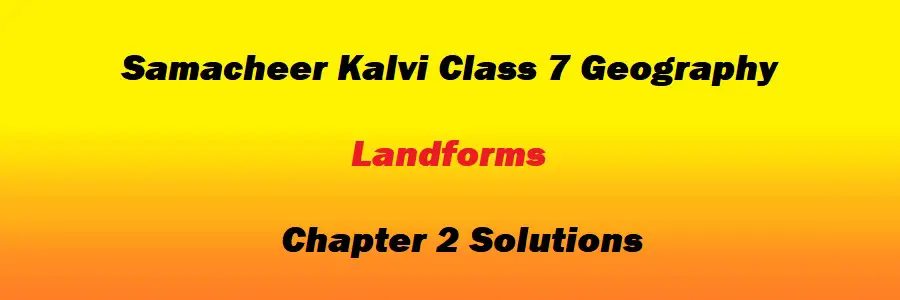Samacheer Kalvi Class 7 Geography Chapter 2 Landforms Solutions
Welcome to NCTB Solutions. Here with this post we are going to help 7th class students by providing Solutions for Samacheer Kalvi Class 7 Geography Chapter 2 Landforms. Here students can easily find all the solved solution for class 7 Social Science, Geography Chapter 2, Landforms Exercise questions. Also here our expert Geography Teacher’s solved all the questions with easily understandable language with proper guidance so that all the students can understand easily. Here on this post students will get Chapter 2 Landforms exercise solutions. Here all the solutions are based on Tamil Nadu State Board latest syllabus.

Landforms Chapter 2 Solutions :
(I) Choose the correct answer
(1) __ is a deposition of river sediments along the foot-hills.
(a) Plunge pool
(b) Alluvial fan
(c) Flood plain
(d) Delta
Answer :
Correct Option → (b)
Alluvial fan is a deposition of river sediments along the foot-hills.
(2) Courtallam falls is located across the ____ river
(a) Cauvery
(b) Pennar
(c) Chittar
(d) Vaigai
Answer :
Correct Option → (c)
Courtallam falls is located across the Chittar river.
(3) The landform created by glacial deposition is
(a) Cirque
(b) Arete
(c) Moraine
(d) Tarn lake
Answer :
Correct Option → (c)
The landform created by glacial deposition is Moraine
(4) Large deposits of loess are found in
(a) USA
(b) India
(c) China
(d) Brazil
Answer :
Correct option – (c)
Large deposits of loess are found in China.
(II) Fill in the blanks
(1) The process of breaking and crumbling of rocks is __
(2) The place where the river joins a lake or a sea is known as __
(3) Inselbergs are found in the __ desert in South Africa.
(4) A cirque is known as __ in Germany.
(5) The longest beach in the world is __
Answer :
(1) → Weathering
(2) → River mouth
(3) → Kalahari
(4) → Kar
(5) → Miami
(III) Match the following
(1) Breaking and crumbling of rocks – Glacier
(2) Abandoned meander loops – Barchans
(3) Large body of moving ice – Lagoon
(4) Crescent shaped sand dunes – Weathering
(5) Vembanad lake – Oxbow lake
Answer :
(1) Breaking and crumbling of rocks → Weathering
(2) Abandoned meander loops → Oxbow lake
(3) Large body of moving ice → Glacier
(4) Crescent shaped sand dunes → Barchans
(5) Vembanad lake → Lagoon
(IV) Consider the following statement and tick the appropriate answer
(1) Assertion (A) : The deltas are formed near the mouth of the river
Reason (R) : The velocity of the river becomes slow when it approaches the sea.
(a) Both A and R are correct
(b) A is correct and R is wrong
(c) A is wrong and R is correct
(d) Both A and R are wrong
Answer :
The answer is option (a)
Both A and R are correct.
(2) Assertion (A) : The deltas are formed near the mouth of the river
Reason (R) : The velocity of the river becomes slow when it approaches the sea.
(a) Both A and R are correct
(b) A is correct and R is wrong
(c) A is wrong and R is correct
(d) Both A and R are wrong
Answer :
The correct option is – (a)
Both A and R are correct.
(V) Answer the following
(1) Define erosion.
Answer :
Erosion is the process of destruction of land by air water or other natural agents.
(2) What is a plunge pool?
Answer :
Over the rocky beds of hilly stream more of less circular depression called potholes from because of stream erosion aided by the abrasion of rock fragments.
(3) How are Ox – bow lakes formed?
Answer :
The edges of the meander loop move closer and closer as a result of continuous erosion. In this way two ends are attached at a time. As a result it is separated from the main river and froms a pond. Which is known as oxbow lake.
(4) Name the major landforms formed by glacial erosion.
Answer :
Cirque, Aretes, U’ Shaped Valley are major landfroms formed by glacial erosion.
(5) Give a note on Mushroom rocks.
Answer :
If the lower part of a rock is more eroded as a result of wind erosion, it looks like mushrooms, it is called mushrooms rock.
(6) What is a lagoon? Give an example.
Answer :
The lagoon is a lakes isolated from the sea.
Example : Chilka lake in Odisha.
(VI) Distinguish the following
(1) Tributary and Distributary
Answer :
- Tributary :
(1) When a few small rivers join a main river, it is called a tributary.
(2) Tributary rivers supply water to the main river.
(3) These rivers are formed from glacier springs etc.
- Distributary :
(1) When the main river divides into many branches, it is called a distributary.
(2) Water is supplied to these rivers from the main river.
(3) The distributaries are formed from the main river.
(2) ‘V’ shaped valley and ‘U’ shaped valley
Answer :
- V shaped valley :
(1) V shaped valleys are formed mainly as a result of river erosion.
(2) This valley can be seen all over the world except the icy regions.
(3) Example – grand canyon
- U shaped valley :
(1) U shaped valleys are formed mainly as a result of glacier erosion.
(2) Such valleys are commonly found in high mountain glaciers region.
(3) Example – Leh Valley in Ladakh
Next Chapter Solution :
👉 Population and Settlement